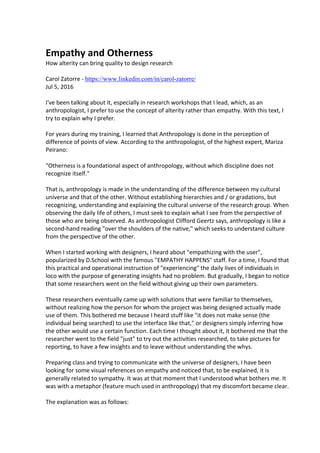Empathy and Otherness
- 1. Empathy and Otherness How alterity can bring quality to design research Carol Zatorre - https://www.linkedin.com/in/carol-zatorre/ Jul 5, 2016 I've been talking about it, especially in research workshops that I lead, which, as an anthropologist, I prefer to use the concept of alterity rather than empathy. With this text, I try to explain why I prefer. For years during my training, I learned that Anthropology is done in the perception of difference of points of view. According to the anthropologist, of the highest expert, Mariza Peirano: "Otherness is a foundational aspect of anthropology, without which discipline does not recognize itself." That is, anthropology is made in the understanding of the difference between my cultural universe and that of the other. Without establishing hierarchies and / or gradations, but recognizing, understanding and explaining the cultural universe of the research group. When observing the daily life of others, I must seek to explain what I see from the perspective of those who are being observed. As anthropologist Clifford Geertz says, anthropology is like a second-hand reading "over the shoulders of the native," which seeks to understand culture from the perspective of the other. When I started working with designers, I heard about "empathizing with the user", popularized by D.School with the famous "EMPATHY HAPPENS" staff. For a time, I found that this practical and operational instruction of "experiencing" the daily lives of individuals in loco with the purpose of generating insights had no problem. But gradually, I began to notice that some researchers went on the field without giving up their own parameters. These researchers eventually came up with solutions that were familiar to themselves, without realizing how the person for whom the project was being designed actually made use of them. This bothered me because I heard stuff like "it does not make sense (the individual being searched) to use the interface like that," or designers simply inferring how the other would use a certain function. Each time I thought about it, it bothered me that the researcher went to the field "just" to try out the activities researched, to take pictures for reporting, to have a few insights and to leave without understanding the whys. Preparing class and trying to communicate with the universe of designers, I have been looking for some visual references on empathy and noticed that, to be explained, it is generally related to sympathy. It was at that moment that I understood what bothers me. It was with a metaphor (feature much used in anthropology) that my discomfort became clear. The explanation was as follows:
- 2. SYMPATHY: Feeling penalized by the pain the other individual feels when wearing such shoes. EMPATHY: It is a person to wear someone's high heels for miles and PERCEIVE how uncomfortable the experience is. (the original text was about using Apache moccasins for miles ...). Let me then use this same metaphor to present what is otherness: Establishing otherness means perceiving yourself in relation to the "judgment" on the jumping shoes, considering that they are uncomfortable from the point of view of the researcher. This point of view may differ from the respondent's understanding, because even with the frequent use of jumping shoes the feet can become accustomed and stop hurting. Through alterity, ethnographic research is oriented toward understanding the REASONS and REASONS that cause people to wear such shoes. Conclusion My annoyance is with the use of EMPATIA in a raw way, only an experience that does not problematize the space searched. Therefore, I prefer to use the concept of otherness, I want to not only experience the experience of the other, but mainly to understand such experience from his logic. There is another aspect that needs to be questioned: the political dimension of otherness in relation to empathy. There are cases in which one simply cannot experience the practical experience of the group being researched, try to imagine a male individual "experiencing" a gestation for example. In certain experiences, it is simply not possible to feel what the other feels from a biopsychosocial point of view, but this will be for other texts. References GEERTZ, Clifford. The interpretation of cultures. Rio de Janeiro: Guanabara, c1989. 323p. (Social Anthropology).) PEIRANO, Mariza G. S. (Mariza Gomes e Souza). The lived theory: and other anthropological essays. Rio de Janeiro: J. Zahar, 2006. 197 p. Includes bibliography. ISBN 8571109419 (Bro.). SILVA, Vagner Gonçalves da. The anthropologist and his magic: field work and ethnographic text in anthropological research on Afro-Brazilian religions. SÃĢo Paulo: EDUSP, 2006. 194 p., Il. Bibliography. ISBN 8531405718 (Bro.). https://www.ideo.com/images/uploads/news/pdfs/Empathy_on_the_Edge.pdf http://midia.atp.usp.br/impressos/redefor/Sociologia/M2_PluraCult/M2_PluraCult_Tema2. pdf


